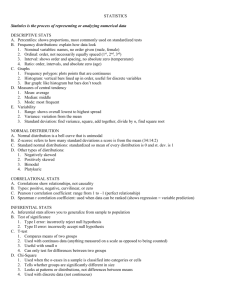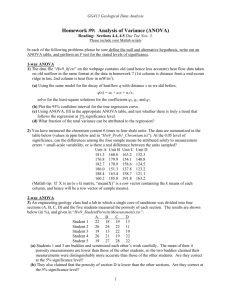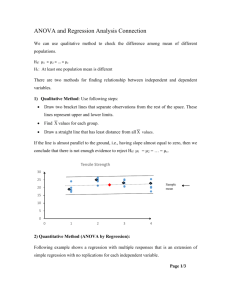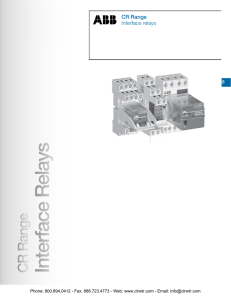Exam One Review Questions
advertisement
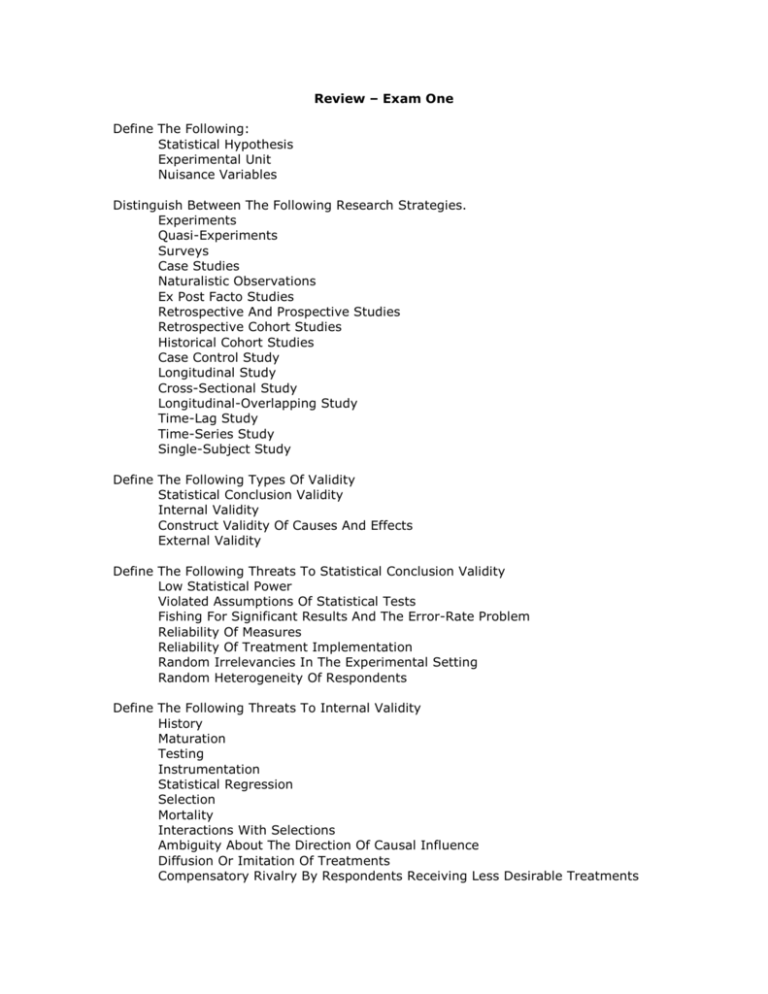
Review – Exam One Define The Following: Statistical Hypothesis Experimental Unit Nuisance Variables Distinguish Between The Following Research Strategies. Experiments Quasi-Experiments Surveys Case Studies Naturalistic Observations Ex Post Facto Studies Retrospective And Prospective Studies Retrospective Cohort Studies Historical Cohort Studies Case Control Study Longitudinal Study Cross-Sectional Study Longitudinal-Overlapping Study Time-Lag Study Time-Series Study Single-Subject Study Define The Following Types Of Validity Statistical Conclusion Validity Internal Validity Construct Validity Of Causes And Effects External Validity Define The Following Threats To Statistical Conclusion Validity Low Statistical Power Violated Assumptions Of Statistical Tests Fishing For Significant Results And The Error-Rate Problem Reliability Of Measures Reliability Of Treatment Implementation Random Irrelevancies In The Experimental Setting Random Heterogeneity Of Respondents Define The Following Threats To Internal Validity History Maturation Testing Instrumentation Statistical Regression Selection Mortality Interactions With Selections Ambiguity About The Direction Of Causal Influence Diffusion Or Imitation Of Treatments Compensatory Rivalry By Respondents Receiving Less Desirable Treatments Resentful Demoralization Of Respondents Receiving Less Desirable Treatments Define The Following Threats To External Validity Interaction Of Testing And Treatment Interaction Of Selection And Treatment Interaction Of Setting And Treatment Interaction Of History And Treatment Reactive Arrangements Multiple-Treatment Interference Define These Other Threats To Valid Inference Making Experimenter-Expectancy Effect Demand Characteristics Subject-Predisposition Effects Cooperative-Subject Effects Screw You Effect Evaluation Apprehension Faithful Subjects Placebo Effect Define The Following Approaches To Control Single-Blind Procedure Double-Blind Procedure Deception Disguised-Experiment Technique Multiple Researchers Debriefing Experimenter-Expectancy Control Groups Unrelated-Experiment Technique Quasi-Control Group Yoked Control Procedure Introduction to Designs Write the null hypotheses available to be tested, the experimental design model equation, describe each component in the equation, and write the layout for each of the following designs. CR-p RB-p LS-p CRF-pq Fundamental Assumptions in ANOVA Who derived the chi-square distribution and what are its characteristics? What is the importance of the chi-square distribution in ANOVA? Who derived the F distribution and what are its characteristics? What is the importance of the F distribution in ANOVA? Who derived the t distribution and what are its characteristics? What is the importance of the t distribution in ANOVA? What are four general assumptions in using the F distribution in hypothesis testing? Partitioning Variances Discuss the partitioning of SSTO in the CR-p design. Distinguish between a fixed-effects and a random-effects model. List the rules associated with deriving the expected mean squares for a CR-p design. List the three fundamental assumptions in deriving the expected mean squares for a CR-p design. More on ANOVA Assumptions List, again, the four assumptions necessary to use the F. List, again, the three assumptions necessary to use the CR-p design. Describe the effect of violation of each of the above assumptions on computation and interpretation. Multiple Comparison Tests Distinguish between per-contrast, familywise, and per-family error rates. Define the three kinds of test statistics in multiple comparison procedures. Distinguish between a single-step and a multiple-step procedure. What is coherence? Which multiple comparison procedure is appropriate for each of the following (form two columns for each: one when assumptions are tenable and one when they are not): A priori orthogonal A priori nonorthogonal (control mean) A priori nonorthogonal (C contrasts) A posteori orthogonal A posteori nonorthogonal (all pairwise) A posteori nonorthogonal (all contrasts) What are the assumptions associated with using the Student’s t? When is Dunnet’s test applicable? What does Dunn’s procedure involve? Discuss alpha. When is the Dunn-Sidak test appropriate? What is the difference between this procedure and the Dunn procedure? Discuss the differences between Holm’s procedure and the D-S procedure. When is Tukey’s HSD test appropriate? What is the procedure for Tukey’s HSD? What is / are the procedure(s) when the n’s are equal? What is / are the procedure(s) when the n’s are unequal? What is / are the procedure(s) when the variances are heterogeneous? When is the Fisher-Hayter test appropriate? Discuss the contribution of each of the following to the REGW procedure. Ryan Einot and Gabriel Welsch Shaffer When is Scheffe’s S test appropriate? When is the Brown-Forsythe test appropriate? Completely Randomized Design List two conditions (in addition to those of ANOVA) required for the CR-p design. Write the layout for a CR-p design. Write the experimental design model equation for a CR-p design and indicate what each term means. Why is exploratory data analysis performed? What are the null hypotheses that can be tested in the CR-p design? Write the general ANOVA table for a CR-p design. Compare the expected mean squares for models I and II. List five major advantages and two major disadvantages to the CR-p design. General Linear Model What is a linear model? What is the linear model in matrix terms? What is a structural matrix? How are parameters estimated in the regression model? What is dummy coding? Write the regression equation using dummy coding. What is effect coding? Write the regression equation using effect coding. What is orthogonal coding? What is the correspondence between parameters of the regression and ANOVA models? What is the cell means model? Why is the cell means model used?
